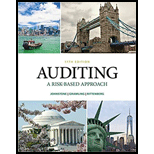
AUDITING-TEXT (LOOSELEAF)
11th Edition
ISBN: 9781337619462
Author: JOHNSTONE
Publisher: CENGAGE L
expand_more
expand_more
format_list_bulleted
Question
Chapter 3, Problem 29CYBK
To determine
Introduction: Monitoring is a procedure that gives input on the adequacy of each of the five parts of inner control. The board chooses a blend of progressing assessments, separate assessments, or a blend of the two to achieve monitoring.
To state: If the given statement is true or false.
Expert Solution & Answer
Want to see the full answer?
Check out a sample textbook solution
Students have asked these similar questions
Can you help me solve this accounting question using the correct financial procedures?
General accounting question
What is the cost of goods sold?
Chapter 3 Solutions
AUDITING-TEXT (LOOSELEAF)
Ch. 3 - Prob. 1CYBKCh. 3 - Prob. 2CYBKCh. 3 - Which of the following are affected by the quality...Ch. 3 - Prob. 4CYBKCh. 3 - Prob. 5CYBKCh. 3 - Prob. 6CYBKCh. 3 - What are the components of internal control per...Ch. 3 - Prob. 8CYBKCh. 3 - Prob. 9CYBKCh. 3 - The control environment is seen as the foundation...
Ch. 3 - Prob. 11CYBKCh. 3 - Which one of the following components of internal...Ch. 3 - Prob. 13CYBKCh. 3 - Prob. 14CYBKCh. 3 - Prob. 15CYBKCh. 3 - Prob. 16CYBKCh. 3 - Prob. 17CYBKCh. 3 - Prob. 18CYBKCh. 3 - Prob. 19CYBKCh. 3 - Prob. 20CYBKCh. 3 - Prob. 21CYBKCh. 3 - Prob. 22CYBKCh. 3 - Prob. 23CYBKCh. 3 - Prob. 24CYBKCh. 3 - Prob. 25CYBKCh. 3 - Prob. 26CYBKCh. 3 - Prob. 27CYBKCh. 3 - Prob. 28CYBKCh. 3 - Prob. 29CYBKCh. 3 - Prob. 30CYBKCh. 3 - Prob. 31CYBKCh. 3 - Prob. 32CYBKCh. 3 - Prob. 33CYBKCh. 3 - Prob. 34CYBKCh. 3 - Prob. 35CYBKCh. 3 - Prob. 36CYBKCh. 3 - Prob. 37CYBKCh. 3 - Prob. 38CYBKCh. 3 - Prob. 39CYBKCh. 3 - Prob. 40CYBKCh. 3 - Prob. 1RQSCCh. 3 - Prob. 2RQSCCh. 3 - Prob. 3RQSCCh. 3 - Prob. 4RQSCCh. 3 - Distinguish between entity-wide and transaction...Ch. 3 - Refer to Exhibit 3.2. List the principles...Ch. 3 - Prob. 7RQSCCh. 3 - Prob. 8RQSCCh. 3 - Prob. 9RQSCCh. 3 - Prob. 10RQSCCh. 3 - Refer to Exhibit 3.3. For each risk assessment...Ch. 3 - Prob. 12RQSCCh. 3 - Prob. 13RQSCCh. 3 - Prob. 14RQSCCh. 3 - Prob. 15RQSCCh. 3 - Prob. 16RQSCCh. 3 - Prob. 17RQSCCh. 3 - Prob. 18RQSCCh. 3 - Authorization of transactions is a key control in...Ch. 3 - Prob. 20RQSCCh. 3 - Prob. 21RQSCCh. 3 - Prob. 22RQSCCh. 3 - Prob. 23RQSCCh. 3 - Prob. 24RQSCCh. 3 - Prob. 25RQSCCh. 3 - Prob. 26RQSCCh. 3 - Prob. 27RQSCCh. 3 - Prob. 28RQSCCh. 3 - Refer to Exhibit 3.9. What are the important...Ch. 3 - Refer to Exhibit 3.10 and Exhibit 3.11. Describe...Ch. 3 - Prob. 31RQSCCh. 3 - Prob. 32RQSCCh. 3 - Prob. 33RQSCCh. 3 - Prob. 34RQSCCh. 3 - Assume that management is gathering evidence as...Ch. 3 - Prob. 36RQSCCh. 3 - Prob. 37RQSCCh. 3 - Prob. 38RQSCCh. 3 - Prob. 39RQSCCh. 3 - Prob. 40RQSCCh. 3 - Prob. 39FFCh. 3 - Diamond Foods, Inc. (LO 8, 9) In February 2012,...
Knowledge Booster
Similar questions
- 4 POINTSarrow_forwardI am looking for the correct answer to this general accounting question with appropriate explanations.arrow_forwardValor Systems is considering a project that will produce incremental annual sales of $320,000 and increase cash expenses by $205,000. If the project is implemented, taxes will increase from $31,000 to $37,000. The company is debt-free. What is the amount of the operating cash flow using the top-down approach? Need helparrow_forward
- Hii! Please don't use ai to answerarrow_forwardSimba Pets uses the perpetual inventory system. At the beginning of the quarter, Simba Pets has $42,000 in inventory. During the quarter, the company purchased $9,200 of new inventory from a vendor, returned $1,500 of inventory to the vendor, and took advantage of discounts from the vendor of $300. At the end of the quarter, the balance in inventory is $34,500. What is the cost of goods sold? A. $15,500 B. $14,900 C. $13,500 D. $16,200arrow_forwardI need help solving this general accounting question with the proper methodology.arrow_forward
arrow_back_ios
SEE MORE QUESTIONS
arrow_forward_ios
Recommended textbooks for you
 Auditing: A Risk Based-Approach (MindTap Course L...AccountingISBN:9781337619455Author:Karla M Johnstone, Audrey A. Gramling, Larry E. RittenbergPublisher:Cengage LearningPrinciples of Accounting Volume 1AccountingISBN:9781947172685Author:OpenStaxPublisher:OpenStax College
Auditing: A Risk Based-Approach (MindTap Course L...AccountingISBN:9781337619455Author:Karla M Johnstone, Audrey A. Gramling, Larry E. RittenbergPublisher:Cengage LearningPrinciples of Accounting Volume 1AccountingISBN:9781947172685Author:OpenStaxPublisher:OpenStax College Auditing: A Risk Based-Approach to Conducting a Q...AccountingISBN:9781305080577Author:Karla M Johnstone, Audrey A. Gramling, Larry E. RittenbergPublisher:South-Western College Pub
Auditing: A Risk Based-Approach to Conducting a Q...AccountingISBN:9781305080577Author:Karla M Johnstone, Audrey A. Gramling, Larry E. RittenbergPublisher:South-Western College Pub

Auditing: A Risk Based-Approach (MindTap Course L...
Accounting
ISBN:9781337619455
Author:Karla M Johnstone, Audrey A. Gramling, Larry E. Rittenberg
Publisher:Cengage Learning

Principles of Accounting Volume 1
Accounting
ISBN:9781947172685
Author:OpenStax
Publisher:OpenStax College


Auditing: A Risk Based-Approach to Conducting a Q...
Accounting
ISBN:9781305080577
Author:Karla M Johnstone, Audrey A. Gramling, Larry E. Rittenberg
Publisher:South-Western College Pub